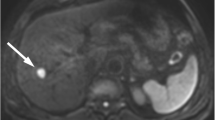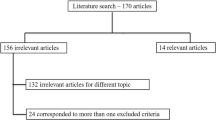Abstract
Background
Intrahepatic and extrahepatic recurrence remains a significant problem for hepatocellular carcinoma (HCC). The aim of this study was to determine the usefulness of diffusion-weighted magnetic resonance imaging (DWI) for histological tumor grading and preoperative prediction of early HCC recurrence within 6 months of operation.
Methods
A total of 44 patients who had undergone hepatic resection for HCC (50 nodules) were reviewed retrospectively. DWI was performed within 30 days before hepatectomy, and apparent diffusion coefficients (ADCs) were measured using 2 methods: mean ADC and minimum-spot ADC. Relationships between ADCs and histological differentiation and between ADCs and early recurrence of HCC were analyzed.
Results
Mean ADC was significantly lower in poorly differentiated HCC (n = 18, 1.07 ± 0.15 × 10−3 mm2/s) than in moderately differentiated HCC (n = 29, 1.29 ± 0.21 × 10−3 mm2/s; P < .05). Minimum-spot ADC was significantly lower in poorly differentiated HCC (n = 18, 0.69 ± 0.19 × 10−3 mm2/s) than in well-differentiated HCC (n = 3, 1.15 ± 0.10 × 10−3 mm2; P < .01) or in moderately differentiated HCC (n = 29, 0.98 ± 0.18 × 10−3 mm2/s; P < .0001). Of 34 patients who were able to be observed for >6 months after resection, 9 showed early recurrence. Minimum-spot ADC was significantly lower in patients with early recurrence (n = 9, 0.64 ± 0.24 × 10−3 mm2/s) than in patients without early recurrence (n = 25, 0.88 ± 0.19 × 10−3 mm2/s; P < .05). On multivariate analysis, minimum-spot ADC was a significant risk factor for early recurrence (P < .05).
Conclusion
Quantitative measurement of ADC of HCC with magnetic resonance diffusion weighted imaging is a promising functional imaging tool in the prediction of histological grade and early recurrence before treatment.



Similar content being viewed by others
References
Kiyosawa K, Uemura T, Ichijo T, Matsumoto A, Yoshizawa K, Gad A, et al. Hepatocellular carcinoma: recent trends in Japan. Gastroenterology. 2004;127:S17–S26.
Park JH, Koh KC, Choi MS, Lee JH, Yoo BC, Paik SW, et al. Analysis of risk factors associated with early multinodular recurrences after hepatic resection for hepatocellular carcinoma. Am J Surg. 2006;192:29–33.
Portolani N, Coniglio A, Ghidoni S, Giovanelli M, Benetti A, Tiberio GA, et al. Early and late recurrence after liver resection for hepatocellular carcinoma. Ann Surg. 2006;243:229–35.
Llovet JM, Fuster J, Bruix J. Intention-to-treat analysis of surgical treatment for early hepatocellular carcinoma: resection versus transplantation. Hepatology. 1999;30:1434–40.
Roayaie S, Blume IN, Thung SN, Guido M, Fiel MI, Hiotis S, et al. A system of microvascular invasion to predict outcome after resection in patients with hepatocellular carcinoma. Gastroenterology. 2009;137:786–8.
Imamura H, Matsuyama Y, Tanaka E, Ohkubo T, Hasegawa K, Miyagawa S, et al. Risk factors contributing to early and late phase intrahepatic recurrence of hepatocellular carcinoma after hepatectomy. J Hepatol. 2003;38:200–7.
Regimbeau JM, Abdalla EK, Vauyhey JN, Lauwers GY, Durand F, Nagorney DM, et al. Risk factors for early death due to recurrence after liver resection for hepatocellular carcinoma: result of a multicenter study. J Surg Oncol. 2004;85:36–41.
Capussotti L, Muratore A, Amisano M, Polastri R, Bouzari H, Massucco P. Liver resection for hepatocellular carcinoma on cirrhosis: analysis of mortality, mobility and survival – a European single center experience. Eur J Surg Oncol. 2005;31:986–93.
Ng KK, Vauthey JN, Pawlik TM, Lauwers GY, Regimbeau JM, Belghiti J, et al. Is hepatic resection for large or multinodular hepatocellular carcinoma justified? Results from multi-institutional data base. Ann Surg Oncol. 2005:12;364–73.
Peng SY, Chen WJ, Lai PL, Jeng YM, Sheu JC, Hsu HC. High alpha-fetoprotein level correlates with high stage, early recurrence and poor prognosis of hepatocellular carcinoma: significance of hepatitis virus infection, age, p53 and beta-catenin mutations. Int J Cancer. 2004;112:44–50.
Stevens WR, Johnson CD, Stephens DH, Batts KP. CT findings in hepatocellular carcinoma: correlation of tumor characteristics with causative factors, tumor size, and histologic tumor grade. Radiology. 1994;191:531–7.
Hayashi M, Matsui O, Ueda K, Kawamori Y, Kadoya M, Yoshikawa J, et al. Correlation between the blood supply and grade of malignancy of hepatocellular nodules associated with liver cirrhosis: evaluation by CT during intraarterial injection of contrast medium. Am J Roentgenol. 1999;172:969–76.
Jang HG, Kim TK, Burns PN, Wilson SR. Enhancement patterns of hepatocellular carcinoma at contrast-enhanced US: comparison with histologic differentiation. Radiology. 2007;244:898–906.
Bulakbasi IM, Kocaoglu M, Ors F, Tayfun C, Uçöz T. Combination of single-voxel proton MR spectroscopy and apparent diffusion coefficient calculation in evaluation of common brain tumors. Am J Neuroradiol. 2003;24:225–33.
Higano S, Yun X, Kumabe T, Watanabe M, Mugikura S, Umetsu A, et al. Malignant astrocytic tumors: clinical importance of apparent diffusion coefficient in prediction of grade and prognosis. Radiology. 2006;241:839–46.
Dow-Mu K, David JC. Diffusion-weighted MRI in the body: Applications and challenges in oncology. Am J Roentgenol. 2007;188:1622–35.
Colagrande S, Carbone SF, Carusi LM, Cova M, Villari N. Magnetic resonance diffusion-weighted imaging: extraneurological applications. Radiol Med. 2006;111:392–419.
Chen YC, Li CW, Kuo YT, Jaw TS, Wu DK, Jao JC, et al. Early response of hepatocellular carcinoma to transcatheter arterial chemoembolization: choline levels and MR diffusion constants—initial experience. Radiology. 2006;239:448–456.
Nishie A, Tajima T, Asayama Y, Ishigami K, Kakihara D, Nakayama T, et al. Diagnostic performance of apparent coefficient for predicting histological grade of hepatocellular carcinoma. Eur J Radiol. doi:10.1016/j.ejrad.201.06.019 [Epub ahead of print].
Heo SH, Jeong YY, Shin SS, Kim JW, Lim HS, Lee JH, et al. Apparent diffusion coefficient value of diffusion-weighted imaging for hepatocellular carcinoma: correlation with histologic differentiation and the expression of vascular endothelial growth factor. Korean J Radiol. 2010;11:295–303.
Nasu K, Kuroki Y, Tsukamoto T, Nakajima H, Mori K, Minami M, et al. Diffusion-weighted imaging of surgically resected hepatocellular carcinoma: imaging characteristics and relationship among signal intensity, apparent diffusion coefficient, and histopathologic grade. Am J Roentgenol. 2009;193:438–44.
Bruix J, Sherman. Management of hepatocellular carcinoma. Hepatology. 2005;42:1208–36.
International Working Party. Terminology of nodular hepatocellular lesions. Hepatology. 1995 22:983–93.
Guo Y, Cai YQ, Cai ZL, Gao YG, An NY, Ma L, et al. Differentiation of clinically benign and malignant breast lesions using diffusion-weighted imaging. J Magn Reson Imaging. 2002;16:172–8.
Guo AC, Cummings TJ, Dash RC, Provenzale JM. Lymphomas and high-grade astrocytomas: comparison of water diffusibility and histologic characteristics. Radiology. 2002;224:177–83.
Calvar JA, Meli FJ, Romero C, Calcagno ML, Yanez P, Martinez AR, et al. Characterization of brain tumors by MRS, DWI and Ki-67 labeling index. J Neurooncol. 2005;72:273–80.
Taouli B, Vilgrain V, Dumont E, Daire JL, Fan B, Menu Y. Evaluation of liver diffusion isotropy and characterization of focal hepatic lesions with two single-shot echo-planar MR imaging sequences. Radiology. 2003;226:71–8.
Lewin M, Poujol-Robert A, Boelle PY, Wendum D, Lasnier E, Viallon M, et al. Diffusion-weighted magnetic resonance imaging for the assessment of fibrosis in chronic hepatitis C. Hepatology. 2007;46:658–65.
Kamel IR, Bluemke DA, Ramsey D, Abusedera M, Torbenson M, Eng J, et al. Role of diffusion-weighted imaging in estimating tumor necrosis after chemoembolization of hepatocellular carcinoma. Am J Roentgenol. 2003;181:708–10.
Park JH, Koh KC, Choi MS, Lee JH, Yoo BC, Paik SW, et al. Analysis of risk factors associated with early multinodular recurrences after hepatic resection for hepatocellular carcinoma. Am J Surg. 2006;192:29–33.
Miller LC, Thrall JF. Clinical molecular imaging. J Am Coll Radiol. 2004;1:4–23.
Author information
Authors and Affiliations
Corresponding author
Rights and permissions
About this article
Cite this article
Nakanishi, M., Chuma, M., Hige, S. et al. Relationship Between Diffusion-Weighted Magnetic Resonance Imaging and Histological Tumor Grading of Hepatocellular Carcinoma. Ann Surg Oncol 19, 1302–1309 (2012). https://doi.org/10.1245/s10434-011-2066-8
Received:
Published:
Issue Date:
DOI: https://doi.org/10.1245/s10434-011-2066-8




